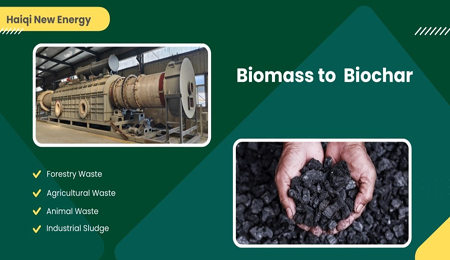What’s the Raw Materials for Biochar?
Biomass Pyrolysis Feedstock Classification Introduction
Woody Biomass: Forestry waste, wood chips, sawdust, discarded wooden pallets, etc. These woody biomasses have high lignin and fixed carbon content and low ash content. These characteristics give it a high energy density and high biochar carbon production. Moreover, the volatile content is moderate, which favours the formation of biochar.
Agricultural Residues: Rice Husk&Straws: Rice husk and straw type feedstock have high content of cellulose, lignin and fixed carbon, which is favourable for the production of high quality biochar. However, we need to pay attention that such raw materials have high ash content and are easy to coking, which may cause pyrolysis equipment clogging.
Nut Shells: Similar to woody biomass, nut shells as well as kernels (coffee bean shells, walnut shells, cashew nut shells, pistachio shells, etc.) contain high fixed carbon and lignin, which is conducive to the production of high-quality biochar.
Bagasse: Rich in lignin and cellulose, suitable for biochar production. The rich moisture content of bagasse is a key factor to be considered. Natural air drying, drying machine drying or waste heat from pyrolysis equipment can be used for drying pre-treatment of bagasse to ensure the efficient operation of the carbonisation equipment.
Coconut Shell: Coconut shell is hard, highly porous and chemically stable, and these characteristics make it an excellent raw material for biochar production. However, the characteristics of coconut shell vary from one origin to another and require special attention when considering biochar production. Compositional analysis of the feedstock is necessary when you are considering starting a biochar project.
Energy Crops: Some energy crops such as switchgrass and miscanthus grow rapidly and produce high yields, which can be used to produce biofuels and biochar, providing a stable supply of feedstock for biochar production.
Livestock Manure: Apart from composting and anaerobic digestion, pyrolysis for biochar is also an effective way to treat livestock manure and add value to it. Pyrolysis can effectively eliminate pathogenic bacteria in livestock manure, providing a green way to achieve harmless and resourceful use of livestock manure.
Challenges for Different Biomass Pyrolysis Feedstocks
Woody Biomass: Uncontrolled deforestation just for economic gain is distressing. If you consider using woody biomass, we would prefer them to be the trimmings of industrial processes, such as sawdust, chips, etc. from sawmills or furniture factories, or residues from forest maintenance, logging, or pallets that have been eliminated from transport ports, and so on. If the tree-based feedstock used for biochar production proves to be unsustainable, your request for biochar carbon credit certification will not be supported.
Agricultural Biomass: Straws and rice hulls are less energy dense and more seasonally available, and additional feedstock purchases may be required during the off-harvest season to keep the facility up and running. In contrast, high-quality biochar production from agricultural waste is more suitable for large-scale farms than for individual households.
Energy Crops: Although energy crops are now an integral part of biofuel production, they require large amounts of water and fertiliser to grow, which has irreversible environmental impacts. The rapid expansion of land for energy crops is crowding out arable land and forests, and to some extent increasing carbon dioxide levels, as energy crops are far less capable of absorbing carbon dioxide than forests.
Livestock Manure: Despite the many advantages of pyrolysis carbonization of animal manure, public acceptance of the use of livestock manure as a resource is still limited to composting and anaerobic digestion for biogas production. Pyrolysis carbonisation of animal manure has not yet appeared in the public eye on a large scale, and its acceptance is relatively low. How to break the development bottleneck of animal manure pyrolysis carbonisation is a topic that needs to be considered by many parties.



.jpg)

